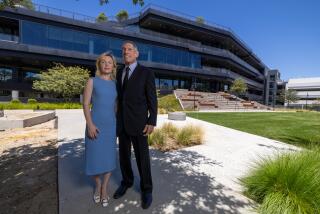Culver City Took Shape in Odd Way
- Share via
Some old-timers still call it the dog track.
The 18-acre site of the proposed Marina Place regional shopping center in Culver City, perched at the tip of Culver City’s long western tentacle, has had a colorful history.
In the early 1900s, wheeler-dealer developer Harry Culver, after whom the city is named, bought chunks of unincorporated land, including the Marina Place lot, as they became available. It was his acquisitive strategy that helped give Culver City its peculiar shape.
“He kept buying little parcels,” said Syd Kronenthal, Culver City’s director of human services and parks.
Kronenthal said he believes it was Culver’s goal to extend his domain as close to the ocean as he could. “He fell short of that,” ending up just east of Lincoln Boulevard, Kronenthal noted.
Culver’s immediate incentive for his western expansion was the development of Venice as a resort modeled after its Italian namesake, complete with canals and gondolas. He bought the 300-foot-wide corridor that runs along Washington Boulevard, which had been an old wagon trail, figuring that businesses on the strip would service and “line the way” to the beach community, said third-generation Culver City resident Julie Lugo Cerra.
In 1926, the Culver City Council annexed 484 acres of unincorporated county land, including the Marina Place site and the Washington Boulevard corridor connecting with the rest of Culver City.
There is some debate among longtime residents whether the Marina Place site was annexed for the express purpose of establishing a greyhound racing track, but the track did open soon after the parcel was made part of the city.
Parimutuel betting was illegal, so instead race patrons would buy “stock” in a dog and cash in on their stock afterward. The greyhound stadium thrived for a couple of years, only to be closed by a statewide ban on dog racing.
The greyhound races were replaced by midget auto races, but not for long--competition from race tracks in Saugus and Gardena and complaints about the noise from neighbors brought the midget cars to a halt.
Rising next in the stadium was “Auction City,” a giant swap meet. Sam Cerra, Culver City’s engineering services supervisor and a longtime resident, said the auction featured “the same kind of people selling the same kind of junk” as one finds on cable television stations nowadays.
McDonnell Douglas Co. bought the property, tore down the stadium and erected hangars in 1956. More than 4,500 people reported to work there. The site later became a Hughes Helicopter factory.
Prudential Insurance Co. bought the lot in 1980, letting the Los Angeles Olympic Organizing Committee use the hangars as a headquarters in 1984. The buildings housed weekend swap meets as recently as a year ago.
The city Planning Department calls it the “Prudential site.” More people call it “Marina Place.” But to those who can remember the old days, it’s still the dog track.
More to Read
Go beyond the scoreboard
Get the latest on L.A.'s teams in the daily Sports Report newsletter.
You may occasionally receive promotional content from the Los Angeles Times.










